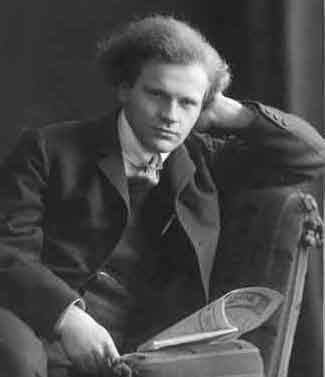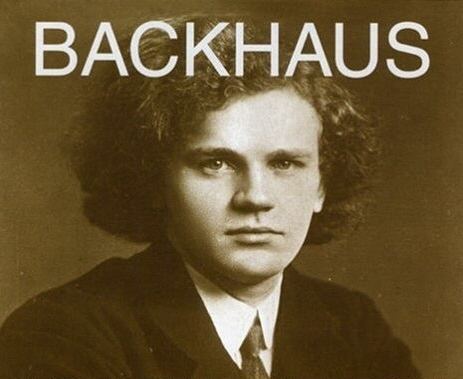Name Wilhelm Backhaus | Role Pianist | |
 | ||
Similar People Hans Schmidt‑Isserstedt, Wilhelm Kempff, Karl Bohm, Pierre Fournier, Emil Gilels | ||
Wilhelm backhaus plays beethoven piano concerto no 5 in eb op 73 emperor 1 4
Wilhelm Backhaus ('Bachaus' on some record labels) (26 March 1884 – 5 July 1969) was a German pianist and pedagogue. He was particularly well known for his interpretations of Beethoven and romantic music such as that by Brahms. He was also much admired as a chamber musician. He seems to have favoured Bosendorfer pianos as he can be seen playing this instrument in commercial videos with Karl Bohm and Hans Knappertsbusch conducting. Also see his original photograph and handwritten letter of appreciation of the Bosendorfer in their main showroom in Vienna.
Contents
- Wilhelm backhaus plays beethoven piano concerto no 5 in eb op 73 emperor 1 4
- Wilhelm backhaus plays beethoven piano concerto no 5 in eb op 73 emperor 4 4
- Musical biography
- Role in Nazi Germany
- Recordings
- In Popular Culture
- Songs
- References

Wilhelm backhaus plays beethoven piano concerto no 5 in eb op 73 emperor 4 4
Musical biography

Born in Leipzig, Backhaus was the son of a well-known architect. He began learning piano at the age of four with his mother, an amateur pianist. The boy's talent was spotted by Artur Nikisch, at whose recommendation Backhaus studied under Alois Reckendorf at the Leipzig Conservatory in the years 1891-99, later taking private piano lessons with Eugen d'Albert in Frankfurt. As a boy of 9 or 10 he was taken to hear both of the Brahms piano concertos performed by d'Albert — and conducted by Brahms himself.

He made his first concert tour at the age of sixteen. In 1905 he won the Anton Rubinstein Competition with Bela Bartok taking second place. He toured widely throughout his life - in 1921 he gave seventeen concerts in Buenos Aires in less than three weeks. Backhaus made his U.S. debut on 5 January 1912 as soloist in Beethoven's 5th Piano Concerto with Walter Damrosch and the New York Symphony Orchestra. In 1930 he moved to Lugano and became a citizen of Switzerland. He died in Villach in Austria where he was to play in a concert. His last recital a few days earlier in Ossiach was recorded.
Role in Nazi Germany

After the seizure of power by the Nazis, Backhaus personally met Adolf Hitler, in May 1933 at the very latest, while accompanying him on a flight to Munich. In the same year he became an executive advisor of the Nazi organization Kameradschaft der deutschen Kunstler (Fellowship of German Artists). For the show elections of 29 March 1936, Backhaus published a statement in the magazine Die Musikwoche under the category of soloist: "Nobody loves German art and especially German music as glowingly as Adolf Hitler…" One month later, on 20 April, Hitler gave Backhaus a professorship, and in September of the same year Backhaus was invited by Hitler to be at the Nuremberg Rally.
The violinist Leila Doubleday Pirani wrote that on November 20, 1938 she attended a concert by Backhaus in London (conducted by Adrian Boult ) with the Viennese Jewish violinist Alma Rose. Ms. Rose told Pirani that Backhaus "was a great friend of the family" so took her backstage to greet the pianist after the concert; but Pirani writes that while "Boult greeted us nicely," Backhaus, upon seeing Rose, "turned his back and walked through a passage"; Pirani called the incident "a stab in the back by this cowardly man, who for fear of his Nazi masters could not behave decently, even in London.". The incident is reported by Richard Newman, who adds that Backhaus eventually moved to Switzerland "in opposition to the Nazi regime" and says his "offensive behavior... may have been due to his awareness of German agents operating in London at the time..."
Recordings
According to some critics, Backhaus was one of the first modern artists of the keyboard (see Alfred Cortot for his antithesis), playing with an objective style, based on greater fidelity to the text. One of the first pianists to leave recordings, he had a long career on the concert stage and in the studio. He recorded the complete piano sonatas and concertos of Beethoven and a large quantity of Mozart and Brahms, and he was also the first to record the Chopin etudes, in 1928; this is still widely regarded as one of the best recordings (Pearl 9902 and others). Recordings of various etudes also exist from the early 1950s, when Backhaus was nearly 70 years old.
His 27 January 1936 recording of Brahms's Waltzes, Op. 39, runs just over thirteen minutes. His studio recordings of the complete Beethoven sonatas, made in the 1960s, display exceptional technique for a man in his seventies (Decca 433882), as do the two Brahms concertos from about the same time (Decca 433895). His live Beethoven recordings are in some ways even better, freer and more vivid (Orfeo 300921). However, his playing could be accused of being "mechanical" and lacking in insight.
His chamber music recordings include Brahms's cello sonatas, with Pierre Fournier, and Schubert's Trout Quintet with the International Quartet and Claude Hobday.
The Times praised Backhaus in its 1969 obituary for having upheld the classical German music tradition of the Leipzig Conservatory. His phenomenal transposing powers spawned many anecdotes: finding the piano a semitone too low at a rehearsal of Grieg's A minor Concerto, he simply played in B flat minor — and then in A minor at the concert, after the instrument had been correctly tuned.
Backhaus was quick to recognize the importance of the gramophone. His 15 July 1909 abridged recording of the Grieg Piano Concerto, lasting about six minutes, was not only the first recording of that work, but the first time any concerto had ever been recorded.
At his death, Backhaus was just completing his second complete Beethoven sonata cycle. All that was missing was the Hammerklavier Sonata — when, according to Stephen Kovacevich, Wilhelm Backhaus was the only pianist to have really understood it. (Excerpts from the book/guide to the “Great Pianists of the 20th Century”, published and © in 1998 by the Philips Music Group).
In Popular Culture
The opening scene in Michelangelo Antonioni's 1961 Italian film, La Notte, features Bernhard Wicki's hospital-bound character, Tommaso Garani, asking Marcello Mastroianni's character, Giovanni Pontano, "How was the Backhaus concert?," to which Giovanni replies simply, "I didn't go."
Songs
Intermezzo in F Minor
Intermezzo in E Flat Minor
Moderato: Sempre energico
III Presto agitato
Serenade From Don Giovanni
Piano Sonata No 8 in C Minor - Op 13 - "Pathetique": I Grave
Verrufene stelle
II Arietta: Adagio molto semplice e cantabile
Piano Sonata No 15 in D Major - Op 28: Allegro
Nr 1 H-Dur
Concerto pour piano No 5 in E-Flat Major - Op 73 "Empereur": II Adagio un poco mosso
Sonate pour piano No 26 in E-Flat Major - Op 81a "Les adieux": II Abwesenheit Andante espressivo
Beethoven: Piano Sonata No20 in G - Op49 No2 - 2 Tempo di Menuetto
Sonata No 17 In D Minor - Op 31 - No 2: Third Movement
Beethoven: Piano Sonata No12 in A flat - Op26 - 1 Andante con variazioni
Concerto pour piano No 2 in B-Flat Major - Op 19: III Rondo Molto allegro
IV Allegro grazioso
Ballade No 3 in B Minor Op 10 : Intermezzo Allegro
Etudes No 12 in C Minor - Op 25
Ballades No 2 - in D Major - Op 10: I Andante
Beethoven: Piano Sonata No24 in F sharp - Op78 "For Therese" - 1 Adagio cantabile - Allegro ma non troppo
Beethoven: Piano Concerto No2 in B flat major - Op19 - 3 Rondo
Walze - Op 39: No 7 in C-Sharp Minor
Piano Sonata No 23 in F Minor - Op 57: III Allegro ma non troppo - Presto
Piano Sonata No 23 in F Minor - Op 57 "Appassionata"
Klaviersonate Nr 21 C-Dur op 53: III Rondo
Piano Sonata No 26 in E Flat Major - Op 81a - "Les Adieux": III The Return
Piano Concerto No 5 in C Minor - Op 10: I Allegro molto con brio
Sonate pour piano No 11 in B-Flat Major - Op 22: III Menuetto
Waldszenen Op82: No 5 Freundliche landschaft
Liebestraume - S541/R211: No 3 Nocturne in A flat major
Six moments musicaux - Op 94 - D 780: No 1 - Moderato
